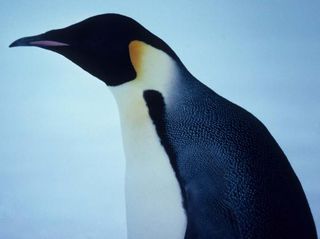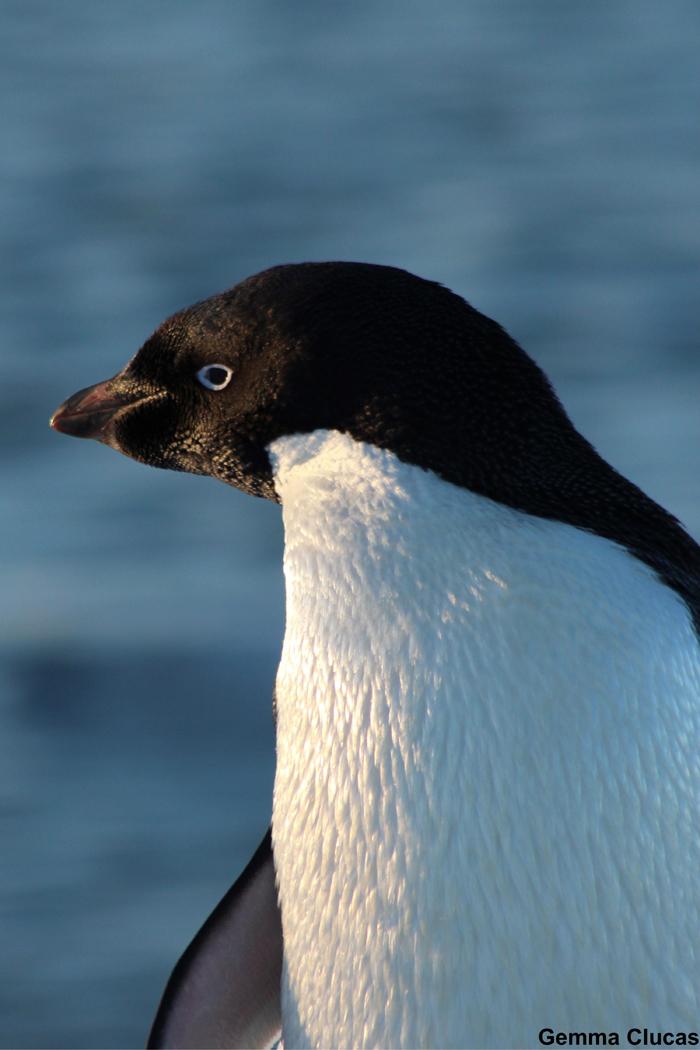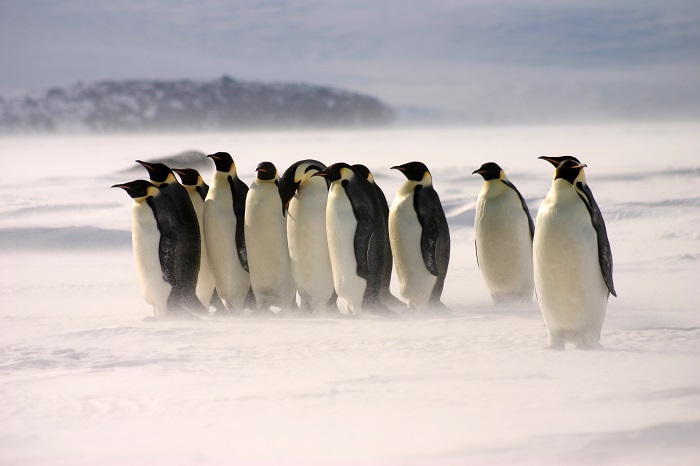Can a Baby Penguin Fit in a Hand
Penguin Facts: Species & Habitat

Penguins are torpedo-shaped, flightless birds that live in the southern regions of the Earth. Though many people imagine a modest, black-and-white animal when they think of penguins, these birds actually come in a diversity of sizes, and some are very colorful.
For example, crested penguins sport a crown of yellow feathers. Blushes of orange and yellow mark the necks of emperor and male monarch penguins. What expect similar bright yellow, bushy eyebrows adorn the heads of some species, such as the Fiordland, royal, Snares and rockhopper penguins. The macaroni penguin's name comes from the crest of yellow feathers on its head, which looks like the 18th-century hats of the same name. A low-cal yellow mask covers the face of the xanthous-eyed penguin around the optics.

Co-ordinate to the Integrated Taxonomic Information Organisation (ITIS), there are 19 species of penguin. (Some experts, however, say the eastern rockhopper is a subspecies of the southern rockhopper.) [Gallery: Photos of 18 Penguin Species]
The smallest penguin species is the little (also called little bluish) penguin. These birds grow to 10 to 12 inches (25.four to xxx.48 centimeters) tall and weigh only 2 to three lbs. (0.xc to i.36 kilograms). The largest penguin is the emperor penguin. It grows to 36 to 44 inches (91.44 to 111.76 cm) tall and weighs 60 to 90 lbs (27.21 to forty.82 kg).
Where exercise penguins live?
Considered marine birds, penguins live up to 80 percent of their lives in the body of water, co-ordinate to the New England Aquarium. All penguins live in the Southern Hemisphere, though it is a mutual myth that they all live in Antarctica. In fact, penguins can exist found on every continent in the Southern Hemisphere. Information technology is also a myth that penguins can only live in common cold climates. The Galapagos penguin, for case, lives on tropical islands at the equator.
What do penguins eat?
Penguins are carnivores; they swallow but meat. Their nutrition includes krill (tiny crustaceans), squid and fish. Some species of penguin tin can make a large dent in an area'due south food supply. For instance, the breeding population of Adélie penguins (about 2,370,000 pairs) can consume upward to i.5 one thousand thousand metric tons (ane.5 billion kg) of krill, 115,000 metric tons (115 million kg) of fish and 3,500 metric tons (3.5 million kg) of squid each year, co-ordinate to Sea World.
The yellow-eyed penguin is very tenacious when foraging for food. Information technology will dive as deep as 120 meters (393.70 anxiety) up to 200 times a day looking for fish, according to the Yellow-Eyed Penguin Trust.
Mating & infant penguins
A group of penguins is chosen a colony, according to the U.S. Geological Survey. During convenance flavor, penguins come ashore to form huge colonies called rookeries, according to Sea Globe.
Most penguins are monogamous. This means that male person and female pairs will mate exclusively with each other for the duration of mating season. In many cases, the male person and female will go along to mate with each other for near of their lives. For example, research has found that chinstrap penguins re-paired with the aforementioned partner 82 percent of the time and gentoo penguins re-paired 90 pct of the time.
At effectually three to eight years old, a penguin is mature enough to mate. Most species brood during the spring and summertime. The male usually starts the mating ritual and will pick out a overnice nesting site before he approaches a female.
Afterward mating, the female emperor or male monarch penguin will lay a single egg. All other species of penguins lay two eggs. The two parents will take turns property the eggs between their legs for warmth in a nest. The ane exception is the emperor penguin. The female person of this species will place the egg on the male's feet to continue warm in his fat folds while she goes out and hunts for several weeks.
When penguin chicks are ready to hatch, they use their beaks to suspension through the shell of their eggs. This process can have upward to three days. After the chicks sally, the parents volition take turns feeding their offspring with regurgitated nutrient. Penguin parents can identify their offspring past unique calls that the chick volition brand.

Nomenclature/taxonomy
The taxonomy of penguins, according to ITIS, is:
Kingdom: Animalia Subkingdom: Bilateria Infrakingdom: Deuterostomia Phylum: Chordata Subphylum: Vertebrata Infraphylum: Gnathostomata Superclass: Tetrapoda Course: Aves Order: Sphenisciformes Family: Spheniscidae Genera: Aptenodytes, Eudyptes, Eudyptula, Megadyptes, Pygoscelis and Spheniscus Species:
- Aptenodytes forsteri (emperor penguin)
- Aptenodytes patagonicus (male monarch penguin)
- Eudyptes chrysocome (southern rockhopper penguin)
- Eudyptes chrysolophus (macaroni penguin)
- Eudyptes filholi (eastern rockhopper penguin; considered by some to be a subspecies of southern rockhopper)
- Eudyptes moseleyi (northern rockhopper penguin)
- Eudyptes pachyrhynchus (Fiordland penguin)
- Eudyptes robustus (Snares penguin)
- Eudyptes schlegeli (purple penguin)
- Eudyptes sclateri (cock-crested penguin)
- Eudyptula minor (trivial penguin, as well called little bluish penguin)
- Megadyptes antipodes (yellow-eyed penguin)
- Pygoscelis adeliae (Adélie penguin)
- Pygoscelis antarcticus (chinstrap penguin)
- Pygoscelis papua (gentoo penguin)
- Spheniscus demersus (jackass penguin, also called African penguin)
- Spheniscus humboldti (Humboldt penguin)
- Spheniscus magellanicus (Magellanic penguin)
- Spheniscus mendiculus (Galapagos penguin)
Conservation status
According to the Ruby Listing of Threatened Species from the International Wedlock for Conservation of Nature, 4 penguin species are endangered: northern rockhopper, erect-crested, yellow-eyed, jackass and Galapagos penguins. Most of the other species of penguins are listed equally vulnerable or threatened.
Other facts
The chinstrap penguin has a stripe of black that runs from ane side of its caput to the other. This strip looks like a chinstrap.
The shape of all penguins makes them aerodynamic. Information technology is the perfect shape for gliding through the water equally they swim.
Most birds take hollow bones. Penguins do non. Their heavier bones counteract the birds' natural buoyancy, making them very quick swimmers. Penguins can swim upwards to 15 mph (24.fourteen kph) according to the World Wild animals Fund.
Rockhoppers do non glide on their bellies like other penguins. They instead hop from stone to rock to move across state quickly.
Additional resources
- New England Aquarium: Penguins - Instructor'southward Guide
- Yellowish-Eyed Penguin Trust: Xanthous-Eyed Penguin Facts
- Ocean Earth: Penguin Guide
- Penguin Science
- Wildlife Conservation Society: Magellanic Penguin
mooreorlintands1970.blogspot.com
Source: https://www.livescience.com/27434-penguin-facts.html

0 Response to "Can a Baby Penguin Fit in a Hand"
Post a Comment